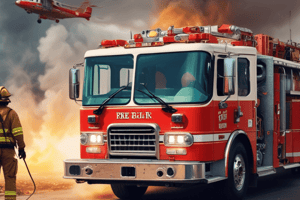Podcast
Questions and Answers
What is the first task upon exiting the fire apparatus?
What is the first task upon exiting the fire apparatus?
- Engaging the pump gear
- Chocking the wheels (correct)
- Checking the water tank level
- Connecting to the hydrant
Which lay starts at the fire and proceeds to the hydrant?
Which lay starts at the fire and proceeds to the hydrant?
- Split (alley) lay
- Forward lay
- Reverse lay (correct)
- Double lay
What is the process of transferring water from an internal tank to an external source?
What is the process of transferring water from an internal tank to an external source?
- Drafting
- Nurse tender operation
- Changeover operation (correct)
- Transition
Which lay is most often used by the first arriving engine at a fire?
Which lay is most often used by the first arriving engine at a fire?
What does seeing a 5 on the transmission selector indicate?
What does seeing a 5 on the transmission selector indicate?
What is the recommended speed to proceed to the fire after stopping at the hydrant?
What is the recommended speed to proceed to the fire after stopping at the hydrant?
When is split lay performed?
When is split lay performed?
What is the recommended practice if the exterior FDC is damaged?
What is the recommended practice if the exterior FDC is damaged?
What is the goal at the beginning of the changeover process?
What is the goal at the beginning of the changeover process?
What does the high idle switch help ensure for the alternator?
What does the high idle switch help ensure for the alternator?
What is the purpose of an inverter?
What is the purpose of an inverter?
What is the purpose of a load sequencer in an automatic load management system?
What is the purpose of a load sequencer in an automatic load management system?
What is the function of a load monitor in an automatic load management system?
What is the function of a load monitor in an automatic load management system?
What does load shedding do in an automatic load management system?
What does load shedding do in an automatic load management system?
What is the most common power source for fire apparatus?
What is the most common power source for fire apparatus?
What is the function of an actuator in a hydraulic rescue tool system?
What is the function of an actuator in a hydraulic rescue tool system?
What is the most common size of electrical cord used with 110 volt powered equipment?
What is the most common size of electrical cord used with 110 volt powered equipment?
Flashcards are hidden until you start studying
Study Notes
Arriving at a Fire
- First task: Assess the situation and determine the best strategy for fighting the fire.
- Lay starting at the fire: The forward lay starts at the fire and connects to the hydrant.
- Transferring water from internal tank to external source: This process is called tanker shuttle and involves connecting the fire apparatus to a water source and using pumps to transfer water from the tank to the hose lines.
- First arriving engine's lay: The most common lay for the first arriving engine at a fire is the forward lay.
- 5 on transmission selector: This indicates that the transmission is in fifth gear, used for cruising speed.
- Recommended speed after hydrant stop: The engine should proceed at a slow, safe speed while ensuring safety for everyone involved.
- Split lay: This lay is performed when multiple fire apparatus are responding to the same fire scene, allowing each engine to connect to a different part of the fire.
- Damaged exterior FDC: If damaged, use a portable pump and hoses to supply water to the fire.
- Goal at the beginning of the changeover process: To maintain a continuous flow of water to the fire.
- High idle switch: Helps ensure the alternator produces enough charge for the electrical system.
Electrical Systems
- Inverter: Converts DC (direct current) to AC (alternating current) to power electronic devices.
- Load Sequencer: Manages the order in which appliances are powered on in an automatic load management system.
- Load Monitor: Monitors the electrical load of the fire apparatus.
- Load Shedding: Automatically reduces the electrical load to prevent overloading the system.
- Power source: The most common power source for fire apparatus is a 12-volt battery system.
- Actuator: A mechanical device used to control the movement of a tool, such as a hydraulic rescue tool.
- Electrical cord size: The most common size for 110-volt powered equipment is 12 gauge.
Studying That Suits You
Use AI to generate personalized quizzes and flashcards to suit your learning preferences.




